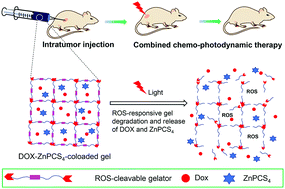A reactive oxygen species (ROS)-responsive low molecular weight gel co-loaded with doxorubicin and Zn(ii) phthalocyanine tetrasulfonic acid for combined chemo-photodynamic therapy†
Abstract
Low molecular weight gels (LMWGs) have significant advantages in drug delivery such as high drug loading capacity, in situ delivery of drug to the lesion site, sustaining drug release with excellent bioavailability, and minimized side effects. Here, we synthesized a reactive oxygen species (ROS)-responsive gelator to prepare an injectable gel. An anticancer drug, doxorubicin hydrochloride (DOX), and a photosensitizer, Zn(II) phthalocyanine tetrasulfonic acid (ZnPCS4), were loaded into the gel for combined chemo-photodynamic therapy. The ROS-responsive gelator was characterized by proton nuclear magnetic resonance (1H NMR) and the morphology of gels was investigated by scanning electron microscopy (SEM). The rheological properties and destruction–recovery capability of both blank and drug-loaded gels were studied. The cytotoxicity of LMWGs against 3T3 fibroblasts and 4T1 breast cancer cells was tested. The in vitro drug release of both drugs was studied and the in vivo anticancer activities of DOX–ZnPCS4-coloaded LMWGs were investigated in tumor-bearing mice. The results revealed that the injectable ROS-responsive DOX–ZnPCS4-coloaded LMWGs exhibited excellent anti-tumor efficacy by a synergistic therapy.



 Please wait while we load your content...
Please wait while we load your content...